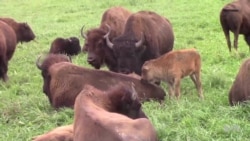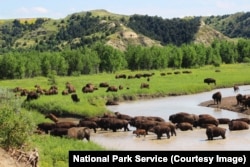Bison are large animals with big heavy brown fur. Also called buffalo, they are the largest mammals in North America.
They stand about 1.83 meters at the shoulder and weigh up to just over 900 kilograms. In 2016, the American bison was officially named the national mammal of the U.S.
Bison once numbered in the millions. Since prehistoric times, they moved around from the Appalachian to the Rocky Mountains in the United States. In the 19th century, people hunted them for meat and hides — people used the skin and fur to make products. They were down to only a few hundred animals by the late 1880s, according to the U.S. Department of the Interior.
Now their numbers are growing. There are an estimated 500,000 bison living in North America. They are increasing in part because they are helping restore lands in the U.S. Fewer than 30,000 wild bison live in conservation herds. But in Indiana, bison are helping undo more than a hundred years of environmental damage.
Ted Anchor is the program manager for the Northwest Indiana Nature Conservancy Program. Standing outside on a windy day, he spoke about the project.
"By creating this large-scale restoration project, we’ve been able to harbor all those species that were just barely hanging on."
Anchor says the 429-hectare reserve used to be the largest lake in Indiana. But in the 19th century, the water was removed and the land was used for agriculture. They cannot bring back the lake, but they can bring back the prairie, or grass covered areas.
Bringing in bison helps both the animals and the land. Bison eat grasses.
"And bison are a really easy way to get short grass prairie. Just by living and doing what bison do which is mostly eat grasses and make little bison—they create the short grass prairie for us."
Now it is a sea of tall dried grass, with some small pieces of spring green. For 20 years, the Indiana chapter of the Nature Conservancy has been working to bring back the prairie at Kankakee Sands Nature Reserve. Late last year they took the last step. They brought in 23 bison, including 16 which were pregnant.
It is the thirteenth herd that the Nature Conservancy owns. They have herds from Mexico all the way up to North Dakota.
In some parts of the U.S. bison are raised for food. But these animals on the reserve will not be raised for meat, but just to manage the environment. The wild herds, or groups, take care of themselves without much help from humans.
What the bison do
The bison’s work is not limited to grazing, or eating the prairie grasses. But when they do, it allows wildflowers to grow. That provides habitats, or housing for rare birds. The bison also roll around on the ground, which creates low areas. These fill up with rainwater, and attract small animals.
It is expected that the Kankakee Sands herd will grow to about 75 animals. Supporters say the land should go back to looking like it did when thousands of bison lived there, long ago.
I’m Anne Ball.
Erika Celeste wrote this story for VOA news. Anne Ball adapted it for Learning English. Hai Do was the editor. We want to hear from you. Write to us in the Comments Section and visit us on our Facebook page.
___________________________________________________________
Words in This Story
prehistoric - adj. of, relating to, or existing in the time before people could write
hide – n. the skin of an animal
herd – n. a large group of animals that live or are kept together
large-scale – adj. covering or involving a large area
prairie – n. a large, mostly flat area of land in North America that has few trees and is covered in grasses












